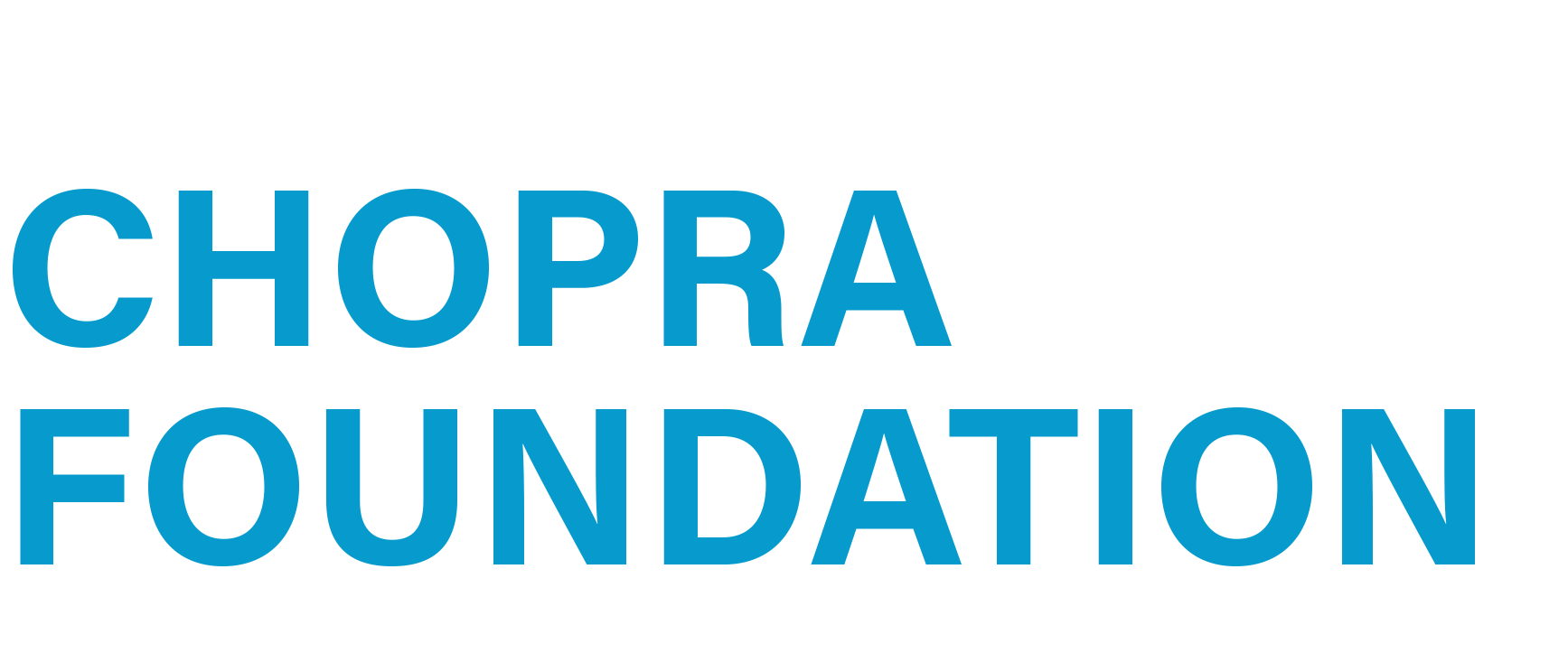Just Going on Vacation May Change Gene Activity
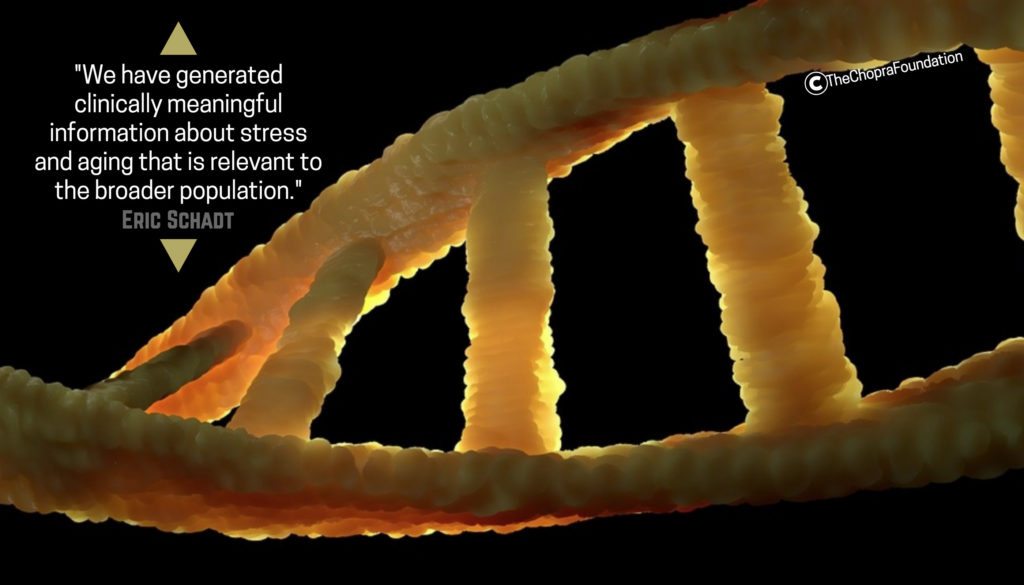
Rustum Roy Spirit Award Recipient, Eric Schadt, interviewed by Reuters. Read: Just Going on Vacation May Change Gene Activity
Source: http://www.nature.com/tp/journal/v6/n8/full/tp2016164a.html
Good News: You Aren’t a Biological Robot
By Deepak Chopra, MD and Rudolph E. Tanzi, PhD
We live in a golden age for neuroscience, and new findings about the brain emerge almost by the month. with huge government backing, one foresees the day, which could be quite soon, when every significant region of the brain is correlated with all the things we use our minds for. But as often happens with exciting frontiers, there’s a tendency to exaggerate the conclusions being reached.
In the case of neuroscience, the overreach is immense, because from many quarters brain researchers keep piling up evidence for very misguided conclusions. All revolve around the notion that we are prisoners of brain activity, in essence trapped inside the chemical and electrical activity of brain cells. Since this activity follows totally deterministic laws, it must follow that we do the same. In the latest wrinkle of “biology is destiny,” our brains have turned us into biological robots. 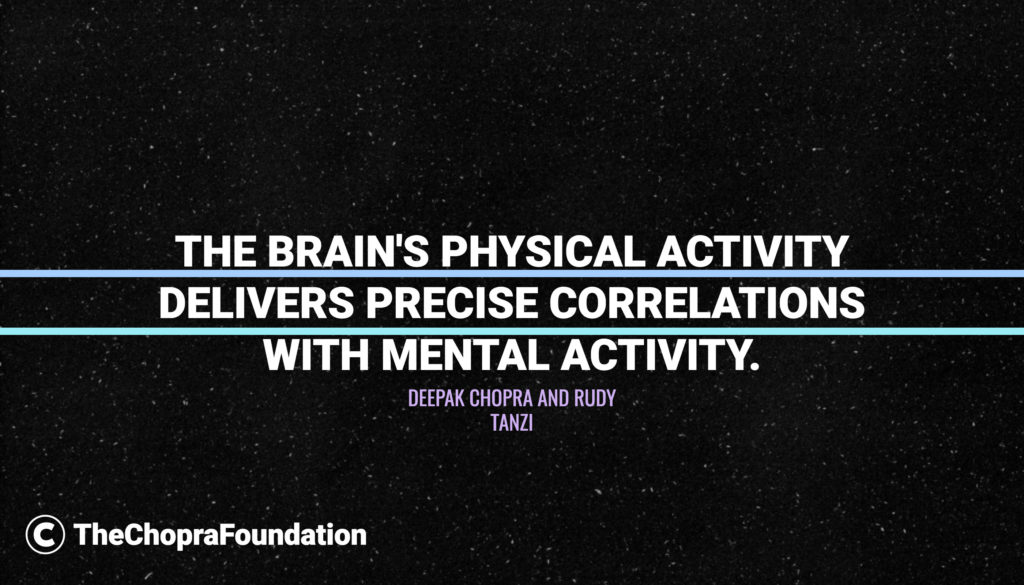
An extreme statement of this position recently appeared in the New York Times, where Robert A. Burton, former chief of neurology at the University of California San Francisco, writes, with damning finality, “. . . it’s hard to avoid the conclusion that the experience of free will (agency) and conscious rational deliberation are both biologically generated illusions.” (Link: http://www.nytimes.com/2016/09/05/opinion/a-life-of-meaning-reason-not-required.html)This isn’t a novel idea, but the fact that others have touted it doesn’t add any validity.
On the face of it, Dr. Burton had to use “conscious rational deliberation’ to write his article, so such a thing obviously exists. He has trusted an illusion to tell him that his own thinking is an illusion, which is totally self-contradictory. If it seems puzzling that a biological robot, however complicated its hard wiring in the brain, could produce the output of Shakespeare, Mozart, and Rembrandt, the reason is that no robot did produce that output–the human mind did.
Getting neuroscientists to back away from the biological robot thesis is difficult, because the vast majority align themselves with an unproven assumption, that the brain produces the mind. Burton admits in his article that no one has any idea where thoughts comes from, yet he proceeds to assure us where they don’t come from, the mind. Brain is all; mind is simply one of its more intriguing byproducts. This is the fallacy of instrumentality, the same as saying that because musical instruments produce music, they also compose it. A piano doesn’t compose ragtime, and there is no proof that the brain produces thought.
All we can say with certainty is that the brain’s physical activity delivers precise correlations with mental activity. Burton makes much of the finding that if you electrically stimulate regions of the brain associated with disgust or empathy, people will experience those feelings. Yet long ago the pioneering Canadian neurosurgeon Wilder Penfield stimulated the motor cortex of patients undergoing brain surgery. As a result of stimulating neurons responsible for activating arm muscles, for example, the patient’s arm would fly up automatically.
Yet Penfield, a great proponent of mind over brain, was astute enough to ask the conscious patients if they had raised their arm. The answer was always no. Instead, patients said something like, “My arm just flew up.” This is enough to show that all of us separate the actions we freely choose from autonomic responses. We can’t be fooled about this. We never say, “My mouth ate some food” or “My hand wants to play the violin.” All the complicated findings in neuroscience are instrumental only. They tell us the equivalent of showing that music can’t be played without musical instruments. The piano is capable of nearly infinite patterns of notes when you consider tempo, dynamics, phrasing, melody, and harmony. This activity is the physical correlation of music, not music itself. The brain’s nearly infinite patterns aren’t thinking, either.
Until neuroscience can actually tell us where thoughts come from, until the link is made between the electrochemical firing of a brain cell and subjective experience, nothing valid can be said about how mind and brain are related. Their relationship has to be holistic. Instead of insisting, as neuroscience does, that brain produces mind, or taking the opposite position, that the mind creates the brain, there is no cause-and-effect between them. They are simultaneous phenomena. A thought is instantly registered in the mental and physical domain.
Where did they both come from? A single source, which is consciousness itself. In fact, brain and mind are two aspects of this deeper reality, where consciousness is the only “stuff” that’s ultimately real. At the moment, however, the concept that we are pre-determined, mechanistic brain puppets is pure science fiction. Decades ago someone joked that figuring out the brain is like putting a stethoscope to the outside of the Astrodome to figure out the rules of football. The fact that various brain experts now take the joke seriously indicates a bad misunderstanding of both brain and mind.
Deepak Chopra MD, FACP, founder of The Chopra Foundation and co-founder of The Chopra Center for Wellbeing, is a world-renowned pioneer in integrative medicine and personal transformation, and is Board Certified in Internal Medicine, Endocrinology and Metabolism. He is a Fellow of the American College of Physicians and a member of the American Association of Clinical Endocrinologists. The World Post and The Huffington Post global internet survey ranked Chopra #17 influential thinker in the world and #1 in Medicine. Chopra is the author of more than 80 books translated into over 43 languages, including numerous New York Times bestsellers. His latest books are Super Genes co-authored with Rudolph Tanzi, PhD and Quantum Healing (Revised and Updated): Exploring the Frontiers of Mind/Body Medicine. www.deepakchopra.com
Dr. Rudolph Tanzi is the Director of the Genetics and Aging Research Unit and Vice-Chair of Neurology at Massachusetts General Hospital. He is also the Joseph P. and Rose F. Kennedy Professor of Neurology at Harvard Medical School. Dr. Tanzi discovered several Alzheimer’s disease (AD) genes and directs the Alzheimer’s Genome Project. He is now actively developing therapies for treating AD based on knowledge gained from genetics and lifestyle interventions. Dr. Tanzi has published over 475 papers and has received the Metropolitan Life Foundation Award, Potamkin Prize, the Smithsonian American Ingenuity Award, and was on the 2015 TIME100 Most Influential People in the World list. He also co-authored the New York Times Bestseller, “Super Brain” and “Super Genes” with Dr. Deepak Chopra.
One Beauty Secret for Everyone
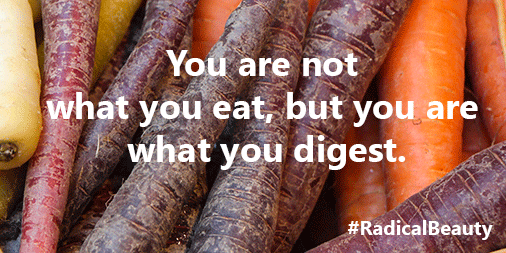
By Deepak Chopra, MD and Kimberly Snyder, CN
The pursuit of beauty, which has been a constant theme throughout recorded history, makes beauty seem like a mysterious gift granted only to the fortunate few. Even now in a scientific age, there’s the constant search for beauty secrets that will bring this gift to many more people. In fact, such a secret does exist, in our view. Instead of saying, “If I’m beautiful I will be happy, the secret is the reverse: “If I’m happy, I will be beautiful.”
This is the axiom of finding beauty from the inside out. There is a rising tide of evidence to show that our cells immediately respond to the inner events in our lives. Being unhappy is a state of mind and body, not simply the mind. There are medical consequences in terms of decreased immune response, for example, among people who are depressed, grief-stricken, lonely, or who have been suddenly terminated from their jobs. This isn’t news. What’s news-worthy is the finer detail, which indicates that no matter how microscopic the scale, all the way down to our genes, shifts in mental activity produce shifts in the wellbeing of cells.
Let’s accept for the moment that the best way to be beautiful is to be happy. Does that really improve the situation? The field of positive psychology, which is relatively new, has discovered that being happy isn’t a simple thing where one prescription works for everyone. And finding a path to increased happiness is tricky. Each of us has a kind of emotional set point we return to as our default. An outside event can cause the needle to move, making us temporarily happier than usual or unhappier. But over time we return to our emotional set point, even after the most extreme events.
Yet happiness is still the key, because two findings from positive psychology appear to be solid. The first is that a happy life is made up from happy days. In other words, waiting to be happy isn’t effective. Being happy today, here and now, is the best strategy. This ties in with the finding that our cells react to our moods. If you work for twenty years at a job that makes you miserable, waiting for retirement day so that you can finally be happy, then during those twenty years you amass cellular changes, including pathways in the brain, that imprint misery–something you will be carrying around biologically and psychologically for many years into your retirement.
What makes for a happy day? In the first post of this series we reduced this question to a matter of input. Our cells recognize only negative input and positive input. Experience is translated into chemicals that either benefit a cell or harm it. Therefore, by focusing on giving the mind-body system positive input every day and decreasing negative input, you are adding to your well-being overall. Here’s a sizable list of positive inputs to pay attention to, as first stated in our last post:
- Pure food, water, and air.
- Avoiding physical and emotional toxins.
- Unprocessed, natural, organic food.
- Nurturing relationships.
- Good sleep.
- Exercise that favors lightness, balance, flexibility, and gracefulness.
- Attitudes of appreciation and gratitude.
- A higher vision of life.
- Service to others.
- Satisfying, meaningful work.
- Mediation and yoga.
- Increased self-esteem.
- The sense of being in control.
- Feeling safe.
- Feeling as if you belong.
- Daily close contact with family and friends.
- Generosity of self through acts of giving.
- Being loved and loving in return.
As a practical matter, you can keep a journal that tracks these positive aspects of life, while at the same time tracking the negative aspects, which are simply the opposite of everything on the list. Most of these things are directly under your control, such as deciding to meditate, and others, such as being in a loving relationship, are things you have a voice in.
So choosing to be happy involves meaningful decisions, which brings us to the second discovery about how to be happy. Despite the effects of outside people and forces pulling against your happiness, and despite the emotional set point, it is estimated that 40-50% of a person’s happiness is dependent on choices made or not made. This is simply an average. It’s likely that some people grow much happier than the norm once they make steady, conscious, positive choices. We already know that such people have much better physical health than the norm, so it’s only logical that the same applies to wellbeing. In our view, “If I’m happy, I will be beautiful” is the beauty secret everyone has dreamed of.
Deepak Chopra MD, FACP, founder of The Chopra Foundation and co-founder of The Chopra Center for Wellbeing, is a world-renowned pioneer in integrative medicine and personal transformation, and is Board Certified in Internal Medicine, Endocrinology and Metabolism. He is a Fellow of the American College of Physicians and a member of the American Association of Clinical Endocrinologists. The World Post and The Huffington Post global internet survey ranked Chopra #17 influential thinker in the world and #1 in Medicine. Chopra is the author of more than 80 books translated into over 43 languages, including numerous New York Times bestsellers. His latest books are Super Genes co-authored with Rudolph Tanzi, PhD and Quantum Healing (Revised and Updated): Exploring the Frontiers of Mind/Body Medicine. www.deepakchopra.com
KIMBERLY SNYDER, C.N., is a nutritionist and the New York Times bestselling author of the Beauty Detox book series. Snyder has appeared as a nutrition and beauty expert on Good Morning America, Dr. Oz, Ellen, Access Hollywood, The Doctors, and Today and has been featured in the New York Times, the Wall Street Journal, Vogue, Vanity Fair, Elle, InStyle, as well as many others. The go-to nutritionist for many of the entertainment industry’s top performers, Snyder is also the creator of Glow Bio, an organic juice, smoothie and cleanse company. She hosts the top-rated podcast Beauty Inside Out on iTunes, and her blog, website, and products have spread the Beauty Detox movement to more than 150 countries. For more information, visit KimberlySnyder.com and RadicalBeauty.com.
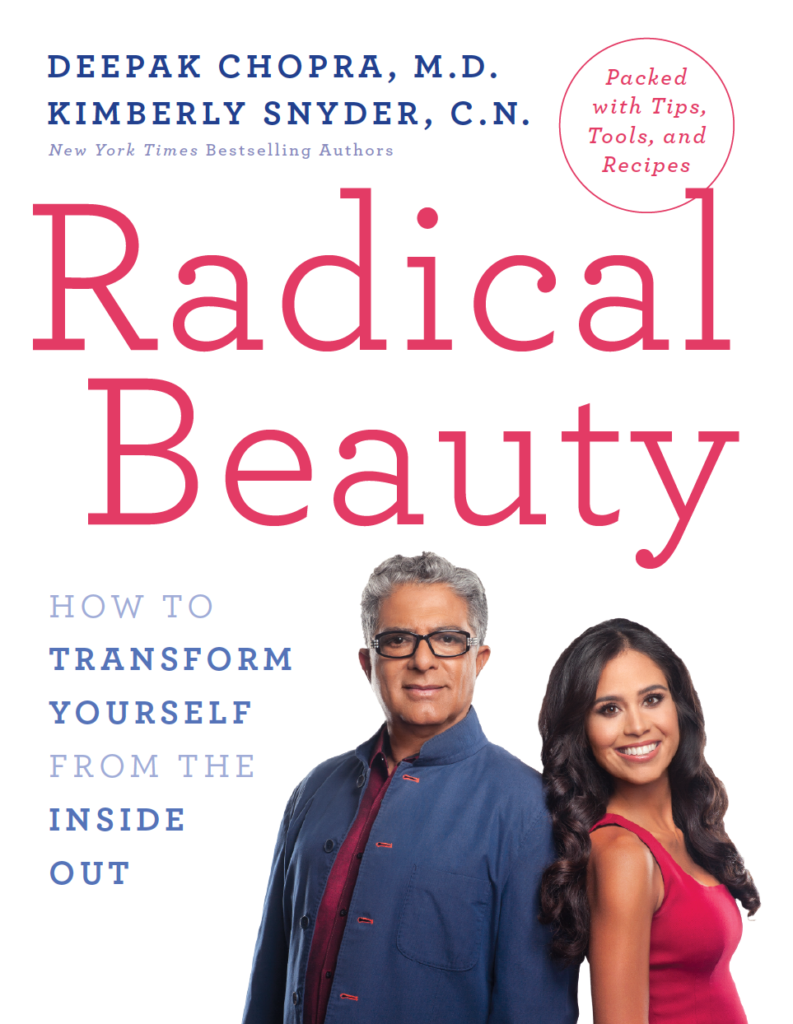
Six-Day Clinical Trial Finds Integrative Medicine Program Alters Blood Serum
Six-Day Clinical Trial Finds Integrative Medicine Program Alters Blood Serum
Meditation, yoga and vegetarian diet linked to decline in plasma metabolites associated with inflammation and cardiovascular disease risk
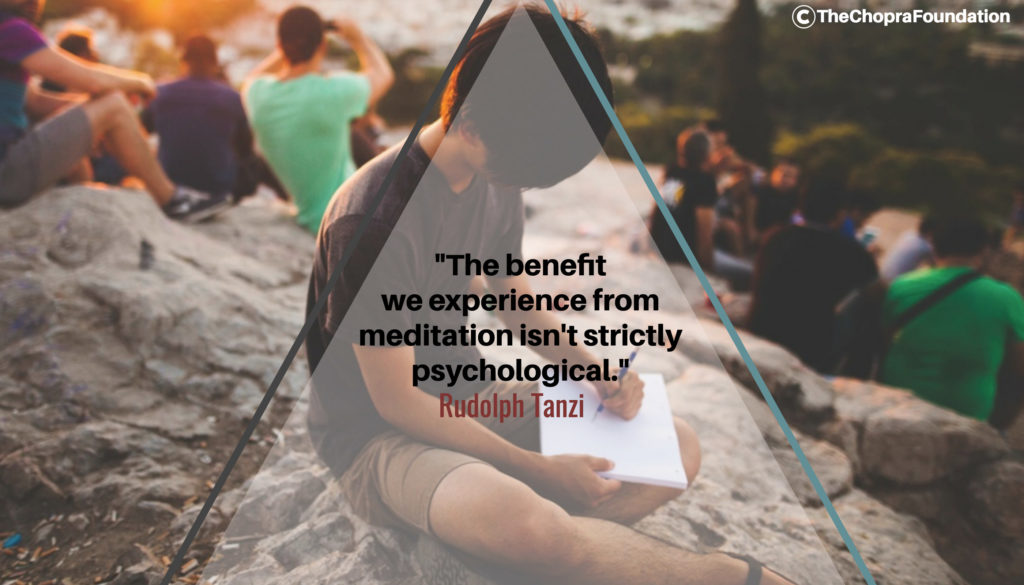
In a novel controlled clinical trial, participants in a six-day Ayurvedic-based well-being program that featured a vegetarian diet, meditation, yoga and massages experienced measurable decreases in a set of blood-based metabolites associated with inflammation, cardiovascular disease risk and cholesterol regulation.
View the Study: Integrative Medicine Program Alters Blood Serum
The findings, published in the September 9 issue of Scientific Reports, represent a rare attempt to use metabolic biomarkers to assess the reported health benefits of integrative medicine and holistic practices. Senior author of the study, which included researchers from multiple institutions, was Deepak Chopra, MD, clinical professor in the Department of Family Medicine and Public Health at University of California San Diego School of Medicine and a noted proponent of integrative medicine.
“It appears that a one-week Panchakarma-based program can significantly alter the metabolic profile of the person undergoing it,” said Chopra, whose foundation provided and managed funding for the study. “As part of our strategy to create a framework for whole systems biology research, our next step will be to correlate these changes with both gene expression and psychological health.”
Study co-author Paul J. Mills, PhD, professor of family medicine and public health and director of the Center of Excellence for Research and Training in Integrative Health, both at UC San Diego, noted that alternative and integrative medicine practices, such as meditation and Ayurveda, are extremely popular, but their effects on the human microbiome, genome and physiology are not fully understood. “Our program of research is dedicated to addressing these gaps in the literature.”
We looked at the effects of a Panchakarma-based Ayurvedic intervention on plasma metabolites in a controlled clinical trial,” said lead author Christine Tara Peterson, PhD, a postdoctoral fellow at UC San Diego. Panchakarma refers to a detoxification and rejuvenation protocol involving massage, herbal therapy and other procedures to help strengthen and rejuvenate the body.”
The study involved 119 healthy male and female participants between 30 and 80 years of age who stayed at the Chopra Center for Wellbeing in Carlsbad, Calif. Slightly more than half were assigned to the Panchakarma intervention (the Chopra Center’s Perfect Health program, which prices start at $2865 for a six-day treatment). The remainder to a relaxation control group. Blood plasma analyses, using liquid chromatography and mass spectrometry, were taken before and after the six-day testing period.
The researchers found that in the Panchakarma group there was a measurable decrease in 12 specific cell-membrane chemicals (phosphatidylcholines) correlating with serum cholesterol and inversely related to Type 2 diabetes risk.
“These phospholipids exert broad effects on pathways related to inflammation and cholesterol metabolism,” said Peterson. “Plasma and serum levels of the metabolites of phosphatidylcholine are highly predictive of cardiovascular disease risk.”
Application of a less stringent measurement standard identified 57 additional metabolites differentially abundant between the two groups of participants, which included additional phosphatidylcholines, sphingomyelins, and others. The authors suggested that given the very short duration of the trial, the serum profile changes were likely driven by the vegetarian diet component of Panchakarma. They said further studies were needed to more fully understand the processes and mechanisms involved.
Co-authors include Arthur M. Moseley, Joseph Lucas, Lisa St John Williams and P. Murali Doraiswamy, Duke University; Elizabeth H. Blackburn and Elissa E. Epel, UC San Francisco; Sheila Patel and Valencia Porter, UC San Diego and The Chopra Center for Wellbeing; Scott N. Peterson, Sanford Burnham Prebys Medical Discovery Institute; Eric E. Schadt, Steven R. Steinhubl and Eric J. Topol, Scripps Translational Science Institute; and Rudolph E. Tanzi, Harvard University.
Funding for this research came, in part, from the Fred Foundation, the MCJ Amelior Foundation, the National Philanthropic Trust, the Walton Family Foundation, the Chopra Foundation and Sybil Robson Orr.
Disclosures: Deepak Chopra is founder of the Chopra Foundation and co-founder of the Chopra Center for Wellbeing. Paul Mills is director of research at the Chopra Foundation.
Full study: Peterson, C. T. et al. Identification of Altered Metabolomic Profiles Following a Panchakarma-based Ayurvedic Intervention in Healthy Subjects. Sci. Rep. 6, 32609; doi: 10.1038/srep32609 (2016).
